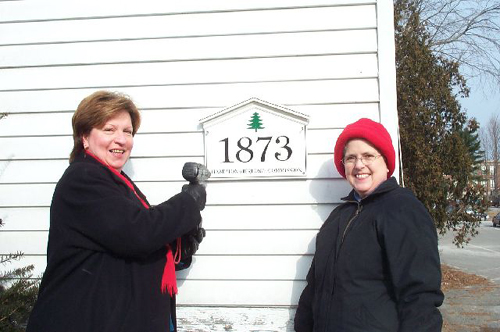By Liz Premo, Atlantic News Staff Writer
Atlantic News, Friday, February 2, 2007
[The following article is courtesy of Atlantic News]

[Atlantic News Photo by Liz Premo]
HAMPTON — The future of the former Hampton District Courthouse may still be hanging in the balance, but an historic marker recognizing the building’s past is now a permanent part of the structure.
In a brief ceremony held on the grounds of the court house last Saturday morning, Hampton Heritage Commission member Maryanne McAden used a power drill to secure the 12″x16″ marker to the façade.
Looking on were several Heritage Commission members, residents and town officials, including Interim Town Manager Mark Gearreald and Building Inspector Kevin Schultz.
The white, hand-painted marker features a green pine tree centered under its peak. The tree logo, a reference to the Native American phrase Winnacunnet (“Beautiful Place of Pines,” as Hampton was first known), was originally used during the town’s tri-centennial celebration back in 1938.
Below the tree’s silhouette is the date the court house was built (1873) and the words “Hampton Heritage Commission” lettered in black.
The marker is a distinctive addition to a building which has, over its storied history, served as a grammar school, the town’s first public Kindergarten, a meeting hall for American Legion Post #35 and a fire station, all before it became the district court. It now stands vacant after official operations were moved to Seabrook in November 2005.
“That looks good,” commented one onlooker once the marker was in place. “That really looks nice,” said another.
What’s really nice is that the Hampton Heritage Commission is offering these markers to the town’s homeowners through a program which is coordinated by McAden.
“It [lets them] show their pride in their home,” she said.
Through this voluntary program, markers can be purchased in order to “identify buildings of historical and architectural significance.”
Crafted by Ould Colony Artisans, the markers are intended for well-maintained buildings that are at least 50 years of age and retain the integrity of their original design.
There are no hard-and-fast rules as far as placement is concerned.
“They can go anywhere,” says Heritage Commission Chairman, Elizabeth Aykroyd. “It’s up to the owner where they put it.”
The markers are $62 each ($7 goes for shipping and handling, the remainder is for the marker itself) and according to Aykroyd, “we get no profit” from sales of the markers.
Those interested in applying for a marker are required to fill out an application and supply specific documents, namely a completed structure survey form, plot plans from the town assessor’s office and a copy of the earliest known deed for the property.
The structure survey asks for a detailed description of the applicant’s home, including the number of stories, the type of foundation, information about specific features (windows, roof and chimneys) and any other details the applicant can supply.
Both McAden and Aykroyd note that the marker applications will provide information about the various properties around town, and will educate the public in the process.
Application forms are expected to be available at the town hall, the Lane Memorial Library, through the Hampton Historical Society, or on the Heritage Commission’s link on the town’s Web site at www.hamptonnh.gov.
The Heritage Commission has already received their first order from a resident on Little River Road, and members are hopeful that this project will generate even greater interest throughout Hampton.
“This is wonderful for us,” said McAden, “and it is wonderful for the town.”